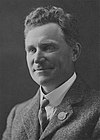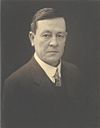Regierung Bruce-Page
Die Regierung Bruce-Page Regierte Australien vom 9. Februar 1923 bis zum 22. Oktober 1929. Der Koalitionsregierung gehörten die Nationalist Party of Australia (NAT) und die Country Party (CP) an.
Die Vorgängerregierung war eine Alleinregierung der Nationalist Party unter Premierminister Billy Hughes.[1] Bei der Parlamentswahl am 16. Dezember 1922 büßte die Nationalist Party Stimmen ein und wurde mit 26 Sitzen nur noch zweitstärkste Partei im Repräsentantenhaus und war auf die 14 Stimmen der Country Party (CP) für die Bildung einer Koalitionsregierung angewiesen.[2] Da der Vorsitzende der Country Party, Earle Page, eine von Hughes geführte Regierung ablehnte, wurde der bisherige Schatzminister Stanley Bruce neuer Premierminister und Page Schatzminister.[3][4] Bei der Parlamentswahl am 14. November 1925 gewann die Nationalist Party 37 Sitze, eine Gewinn von 11 Sitzen, die Country Party hielt ihre 14. Sitze. Im Senat behielt die Nationalist Party ihre 24 Sitze, die bisher nicht vertretene Country Party gewann 4 Sitze.[5] Bei der Parlamentswahl am 17. November 1928 konnte die Nationalist Party einen weiteren Senatssitz gewinnen, im Repräsentantenhaus erhielten die Nationalist Party 29 und die Country Party 13 Mandate.[6] Am 25. September errang die oppositionelle Labor Party, die von Regierungsabgeordneten, darunter dem ehemaligen Premierminister Hughes, unterstützt wurde, bei der Abstimmung über ein Arbeitsgesetz, den Maritime Industrial Bill, eine Mehrheit.[7] Daraufhin fanden am 29. Oktober 1929 Wahlen zum Repräsentantenhaus statt, bei der die Labor Party mit 47 von 76 Sitzen eine klare Mehrheit errang, die Nationalist Party verlor 15 Sitze und die Country Party büßte 3 Site ein.[8] Der Labor-Vorsitzende James Scullin wurde Premierminister der neuen Regierung.[7]
Ministerliste
| Amt | Minister | Partei | Amtszeit | Bild |
|---|---|---|---|---|
| Premierminister und Außenminister | Stanley Bruce | NAT | 9. Februar 1923 – 22. Oktober 1929 | |
| Schatzminister | Earle Page | CP | 9. Februar 1923 – 22. Oktober 1929 | |
| Minister für Inneres und Territorien | George Pearce | NAT | 9. Februar 1923 – 18. Juni 1926 | |
| William Glasgow | NAT | 18. Juni 1926 – 2. April 1927 | ||
| Charles Marr | NAT | 2. April 1927 – 24. Februar 1928 | ||
| Neville Howse | NAT | 24. Februar 1928 – 29. November 1928 | ||
| Aubrey Abbott | CP | 29. November 1928 – 10. Oktober 1928 | ||
| Innenminister | 10. Oktober 1928 – 22. Oktober 1929 | |||
| Generalstaatsanwalt | Littleton Groom | NAT | 9. Februar 1923 – 18. Dezember 1925 | |
| John Latham | NAT | 18. Dezember 1925 – 22. Oktober 1929 | ||
| Generalpostmeister | William Gibson | CP | 9. Februar 1923 – 22. Oktober 1929 | |
| Minister für Handel und Zölle | Austin Chapman | NAT | 9. Februar 1923 – 26. Mai 1924 | |
| Littleton Groom | NAT | 26. Mai 1924 – 13. Juni 1924 | ||
| Herbert Pratten | NAT | 13. Juni 1924 – 7. Mai 1928 | ||
| Stanley Bruce | NAT | 8. Mai 1928 – 24. November 1928 | ||
| Henry Gullett | NAT | 24. November 1928 – 22. Oktober 1929 | ||
| Minister für Arbeit und Eisenbahn | Percy Stewart | CP | 9. Februar 1923 – 5. Mai 1924 | |
| William Hill | CP | 8. Mai 1924 – 29. November 1928 | ||
| William Gibson | CP | 10. Dezember 1928 – 22. Oktober 1929 | ||
| Verteidigungsminister | Eric Bowden | NAT | 9. Februar 1923 – 16. Januar 1925 | |
| Neville Howse | NAT | 16. Januar 1925 – 2. April 1927 | ||
| William Glasgow | NAT | 2. April 1927 – 22. Oktober 1929 | ||
| Gesundheitsminister | Austin Chapman | NAT | 9. Februar 1923 – 26. Mai 1924 | |
| Littleton Groom | NAT | 26. Mai 1924 – 13. Juni 1924 | ||
| Herbert Pratten | NAT | 13. Juni 1924 – 16. Januar 1925 | ||
| Neville Howse | NAT | 16. Januar 1925 – 2. April 1927 | ||
| Stanley Bruce | NAT | 2. April 1927 – 24. November 2928 | ||
| Neville Howse | NAT | 24. November 2928 – 22. Oktober 1929 | ||
| Minister für Märkte und Migration | Victor Wilson | NAT | 9. Februar 1923 – 18. Juni 1926 | |
| Thomas Paterson | CP | 18. Juni 1926 – 19. Januar 1928 | ||
| Minister für Märkte | 19. Januar 1928 – 10. Dezember 1928 | |||
| Minister für Märkte und Verkehr | 10. Dezember 1928 – 22. Oktober 1929 | |||
| Vizepräsident des Executive Council | Llewellyn Atkinson | CP | 9. Februar 1923 – 18. Juni 1926 | |
| George Pearce | NAT | 18. Juni 1926 – 22. Oktober 1929 | ||
| Honorary Minister | Victor Wilson | NAT | 9. Februar 1923 – 16. Januar 1925 | |
| Thomas Crawford | NAT | 14. Februar 1923 – 29. November 1928 | ||
| Charles Marr | NAT | 16. Januar 1925 – 2. April 1927 24. Februar 1928 – 22. Oktober 1929 | ||
| Alexander McLachlan | NAT | 29. August 1926 – 22. Oktober 1929 | ||
| Neville Howse | NAT | 2. April 1927 – 24. Februar 1928 | ||
| James Ogden | NAT | 29. November 1928 – 22. Oktober 1929 | ||
Weblinks
- Parliamentary Handbook for the 45th Parliament. (PDF; 13,4 MB) Part 6: Historical information on the Australian Parliament – Ministries and Cabinets. Parliament of Australia, S. 524 f., abgerufen am 1. Mai 2019 (englisch).
Einzelnachweise
- ↑ L. F. Fitzhardinge: Hughes, William Morris (Billy) (1862–1952). In: Douglas Pike (Hrsg.): Australian Dictionary of Biography. Band 9. Melbourne University Press, Carlton (Victoria) 1983, ISBN 0-522-84273-9 (englisch).
- ↑ Stephen Barber: Federal election results 1901–2016—Reissue 2. (PDF; 2,9 MB) Parliament of Australia, S. 6 f., 25, 139, abgerufen am 1. Mai 2019 (englisch).
- ↑ Heather Radi: Bruce, Stanley Melbourne (1883–1967). In: Douglas Pike (Hrsg.): Australian Dictionary of Biography. Band 7. Melbourne University Press, Carlton (Victoria) 1979, ISBN 0-522-84108-2 (englisch).
- ↑ Carl Bridge: Page, Sir Earle Christmas (1880–1961). In: Douglas Pike (Hrsg.): Australian Dictionary of Biography. Band 11. Melbourne University Press, Carlton (Victoria) 1988, ISBN 0-522-84380-8 (englisch).
- ↑ Stephen Barber: Federal election results 1901–2016—Reissue 2. (PDF; 2,9 MB) Parliament of Australia, S. 7, 26, 139, abgerufen am 1. Mai 2019 (englisch).
- ↑ Stephen Barber: Federal election results 1901–2016—Reissue 2. (PDF; 2,9 MB) Parliament of Australia, S. 7, 27, 139, abgerufen am 1. Mai 2019 (englisch).
- ↑ a b Johannes H. Voigt: Geschichte Australiens. Alfred Kröner, Stuttgart 1988, ISBN 3-520-48801-9, S. 218–230.
- ↑ Stephen Barber: Federal election results 1901–2016—Reissue 2. (PDF; 2,9 MB) Parliament of Australia, S. 7, 28, 139, abgerufen am 1. Mai 2019 (englisch).
Auf dieser Seite verwendete Medien
Senator George Pearce
Thomas Paterson, MP for Gippsland
Commonwealth Coat of Arms of Australia granted by Royal Warrant signed by King George V on 19 September 1912.
IMPORTANT:This image is an artist's interpretation of the original (1912) official version of the Commonwealth Coat of Arms shown in Commons on the Australian coat of arms page. A variant of the original, with a transparent background, is shown on this page.
| “ | Quarterly of six, the first quarter Argent a Cross Gules charged with a Lion passant guardant between on each limb a Mullet of eight points Or; the second Azure five Mullets, one of eight, two of seven, one of six and one of five points of the first (representing the Constellation of the Southern Cross) ensigned with an Imperial Crown proper; the third of the first a Maltese Cross of the fourth, surmounted by a like Imperial Crown; the fourth of the third, on a Perch wreathed Vert and Gules an Australian Piping Shrike displayed also proper; the fifth also Or a Swan naiant to the sinister Sable; the last of the first, a Lion passant of the second, the whole within a Bordure Ermine; for the Crest on a Wreath Or and Azure A Seven-pointed Star Or, and for Supporters dexter a Kangaroo, sinister an Emu, both proper. | ” |
Percy Stewart at the first official cabinet meeting in Canberra.
Australian politician and army officer William Glasgow standing on a ship
Stanley Bruce, Prime Minister of Australia 1923-1926
Llewellyn Atkinson, Australian politician
Sir Henry Somers Gullett, Australian politician
John Latham as Leader of the Opposition in January 1931
Earle Page c. 1920
First Bruce Australian Federal Ministry.
Left to right: Standing:
- William Gibson, Postmaster-General
- Percy Stewart, Minister for Works and Railways
- Eric Bowden, Minister for Works and Railways
- Austin Chapman, Minister for Trade and Customs
- Victor Wilson, Honorary Minister
- Llewellyn Atkinson, Vice-President of the Executive Council
Seated:
- George Pearce, Minister for Home and Territories
- Stanley Bruce, Prime Minister and Minister for External Affairs
- Lord Forster, Governor-General
- Earle Page, Treasurer
- Littleton Groom, Attorney-General














































